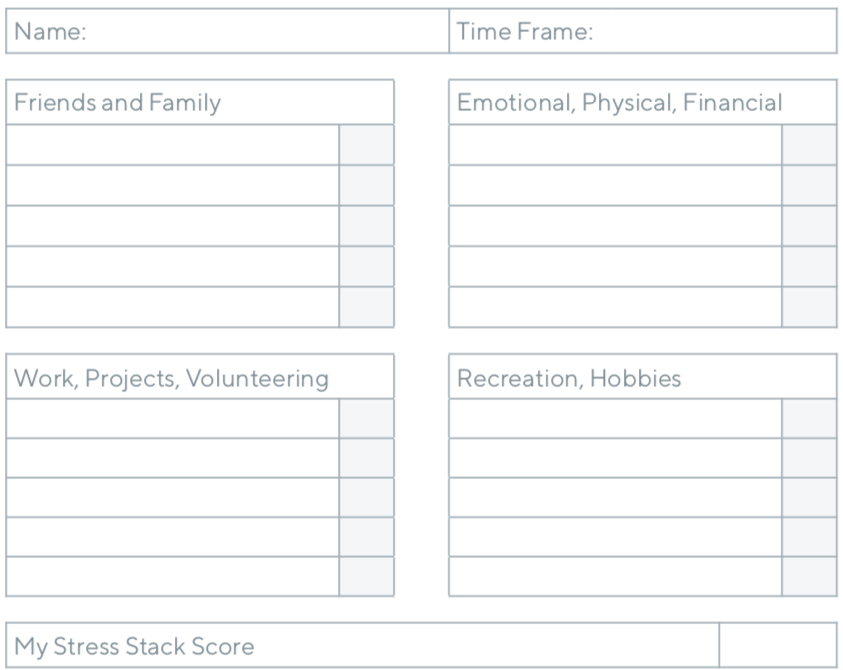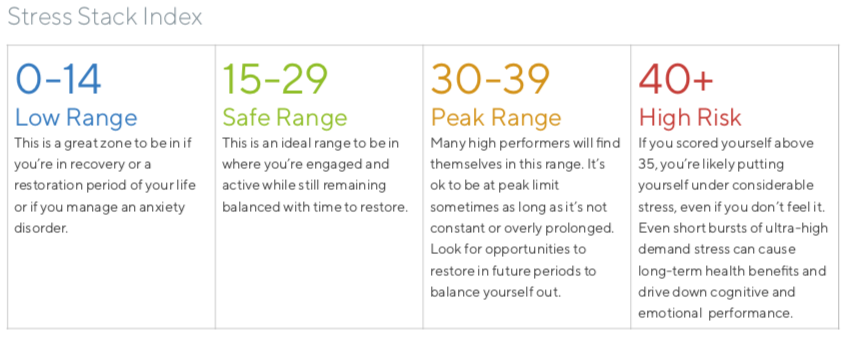The human body and mind were designed to manage stress. When we go to the gym or take a yoga class, we’re putting physical stress on our body which helps activate the muscle systems, manage hormone production, strengthens our immune system and much more. When we approach a challenging problem at work, we put stress on our brain, which helps us learn and become better at problem-solving. Many of today’s increasing health issues are actually due to people not exposing themselves to enough of the right types of stress, both physically and mentally.
On the other hand, too much stress or chronic stress can also cause a lot of physical and mental health issues. It can be easy to overcommit to obligations and responsibilities across work, community and family and not realize it until you’re in a state of complete burnout. I have a terrible track record of over-committing in my life. I’m overly optimistic about how much time or energy things will take, and get excited about opportunities to learn and accomplish new things which leads me to say yes far too often. So over the last few years, I’ve developed a concept I call “Stress Stack Scoring” as a way to evaluate my current and future stress load in order to make smart choices about what I commit to. In this article, I’ll explain how Stress Stack Scoring works so that you can evaluate your own Stress Stack and, if necessary, find a better sense of balance in your life.
The first thing to understand is that even activities you look forward to can add stress to your life or take energy that you might otherwise use elsewhere. Let’s say you’re planning a friend’s surprise birthday, and that is something you enjoy doing. It still takes hours of your evenings and lots of email, phone calls and chat communications to get everything confirmed, plus there are likely a few loose ends that will cause you stress as the event approaches. That doesn’t mean you don’t love doing it, it just means it is one of the things you’re currently working on that is taking time and energy. If you’re someone who gets really nervous about planning events or wanting to impress your friend, it might actually be highly stressful!
What this evaluation is meant to measure is everything you have going on in your life for a specific period of time, and how much time, energy or stress that activity will involve, or combination of the three. For instance, prepping for mid-term exams is likely an activity that would score fairly high on all three scales. So, whether you categorize an activity “fun” or “not fun”, or “bad” or “good” is irrelevant. Everything you take on or are simply dealing with in your life at any given time comes with some commitment of time, energy or stress. You must consider the total measure of your Stress Stack when making decisions about when to say yes and when to politely decline in order to make sure you stay healthy and balanced.
Here’s how to get started:
-
Take a piece of paper and draw a vertical and horizontal line to break it into four quadrants. Label the four quadrants to match the example below. You can download a blank Stress Stack Worksheet here (print it or save it and open on your computer to edit digitally).

- In each of these quadrants, write down all the activities, or things that are happening in your life as of today and over the next 30 days. If you plan your life further in advance, you could do this for a 60 or 90 day period as well, it’s really up to you.
- You can see from the above items, they won’t all be activities, some like the “bad knee” example, are simply things you’re managing at the time. Some might be sad or seriously stressful, like a friend being sick, others might just require your time and energy and be something you’re looking forward to, like your brother’s wedding.
- Take your time to think about everything you should have on your list and fill it in. It might be good to take a first attempt and then leave it for a few hours before coming back to complete it.
- As you’re adding items to your list, you are also going to give it a rating from 1-5, which is how high or low on the time/energy/stress scale the item is for you. This is based on your own perception, but make sure you take into account any bias you have to underestimate or overestimate the impact of activities and events in your life. For instance, if you’re a more ambitious, “A-type” personality, you’re likely to bias towards underestimating.
- I should note that physical issues like chronic pain can have a big impact on your ability to perform cognitively and emotionally. Even something like low-grade back pain can have a dramatic impact on your personal wellbeing and cause a lot of stress on the body. Think about anything physical you’re encountering and make sure you include it in the Emotional/Physical/Financial quadrant.
- Once you complete your Stress Stack Score, use the chart below to see where you fall.

This can be an eye-opening exercise, and can sometimes present uncomfortable results. What’s important if you scored in the upper two ranges of the Stress Stack Index is to consider how you can mitigate your commitment levels in the future. If you’re in Peak Limit, perhaps it’s finding a vacation time in the next couple of months, book some relaxing activities throughout or plan on reducing your list by one or two items in the next period. If you’re in the High Risk category, it might be wise to immediately look at what you can remove from your list in order to find better balance.
Everyone is different and can tolerate stress at different levels. Ultimately it’s about observing and adjusting as necessary over time to find the right balance for you. Repeat the exercise in regular intervals, and keep previous versions to see your trends over time. If you did the exercise with a 60-day outlook, repeat every 60 days. If someone asks you to participate in a project or activity a few months from now, you can always evaluate your Stress Stack Score for that period of time, based on what you know now. It’s a great way to quickly know when to say yes or no to new opportunities. After all, saying no to the wrong things, ensures you have time to say yes to the things that are aligned with your purpose.





